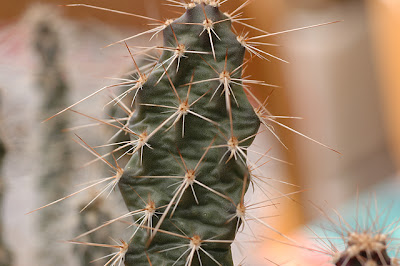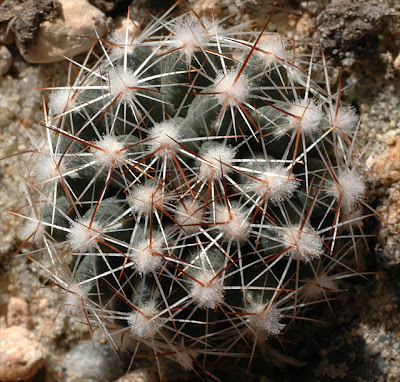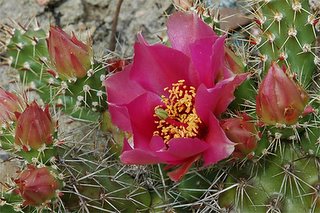The plants in the coldhouse were watered for the first time this season a couple of days ago. They have been kept abstinent from water since the beginning of their dormancy in late October, i.e. for almost 5 months. I’m fascinated by the patterns created by light and shadow on the withered cladodes, and had to take a couple of photos before the plants return to their usual turgid state.
Opuntia compressa (Monmouth County, New Jersey)
Opuntia kaibabensis (SB 1319; Houserock Valley, Arizona)
Opuntia polyacantha var. hystricina (Grand Canyon, Arizona)
The O. polyacantha var. hystricina plants are grown from seeds I collected during a hike down the Grand Canyon.
Escobaria vivipara (south Alberta, Canada)
This E. vivipara has sunken almost completely in on itself. As the stem swells with water the tubercles will soon be fully erect and protruding again.
Wednesday, March 28, 2007
Pictures from the coldhouse
Wednesday, March 21, 2007
Opuntia – post winter status, 2007
As mentioned in yesterdays Delosperma post, this winter has been extremely wet in Denmark but not very cold. All of my cacti, growing in unprotected beds, seem to be coping very well with the conditions, though.
Opuntia polyacantha (Redcliff, Alberta, Canada)
My two Opuntia polyacantha (Redcliff, Alberta, Canada) plants were started from seed (bought from Mesa Garden) in 2004. They spent their first couple of years growing protected in a coldhouse, and were transplanted to an unprotected bed late last spring.
The unprotected Cylindropuntia viridiflora (Pojoaque, New Mexico, USA) plant has been very marked by winter in previous years, but made it through this winter virtually without a scratch.
Cylindropuntia viridiflora (Pojoaque, New Mexico)
The only sign of winter on last years new growth is a slight blushing (displayed against a rusty-red carpet of winter dressed Delosperma 'John Proffit').
Cylindropuntia viridiflora (Pojoaque, New Mexico) – new growth
In general the plants are not as withered as they usually are at this time of year, as is evident from the (mostly) turgid cladodes of this Opuntia tortispina (DJF 1139; w. Albuquerque, New Mexico, USA).
Opuntia tortispina (Albuquerque, New Mexico)
The C. viridiflora and O. tortispina plants were both bought from Uhlig-Kakteen.
BTW, I just realized today is the vernal equinox – a suitable day to post on the status after winter ;-)
Tuesday, March 20, 2007
Delosperma – all dressed up for winter
This winter has been wet, wet, wet in Denmark, but not all that cold. It’s probably not the optimal environment for Delosperma, but the four species I’m currently cultivating certainly don’t seem to mind their growing conditions. Most of the plants have assumed a reddish hue as illustrated by the photos below. All plants are growing in unprotected beds.
Delosperma nubigenum (Sani Pass, 2900m, Lesotho)
Delosperma sp. 'John Proffit' (East Cape Drakensberg)_20070317.jpg)
Delosperma sp. (Sani Pass, Lesotho)
Only the Delosperma sp. (Drakensberg) is its usual bright green self, showing only slight traces of red pigmentation._20070317.jpg)
Delosperma sp. (Drakensberg)
Saturday, March 03, 2007
Flowering Escobaria sneedii
Last summer my Escobaria sneedii (SB 173; Doña Ana County, New Mexico) plants flowered for the first time.
Flowering Escobaria sneedii
The E. sneedii plants are heavily branching, eventually forming large clusters. The stems are obscured by a dense cover of bright snowy white spines, and the flowers are a pale rose-pink with slightly darker midstripes.
The plants are grown in a coldhouse and are exposed to temperatures well below freezing during winter. They are allegedly very rot-prone, so I grow them in an inorganic, mineral soil with extremely good drainage. The plants are kept bone-dry during winter but watered rather freely during their growing season. 
Flowering Escobaria sneedii – top view
I bought the plants from Mesa Garden during a visit to the US a couple of years ago.
Escobaria sneedii is also known as Coryphantha sneedii.


